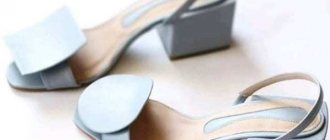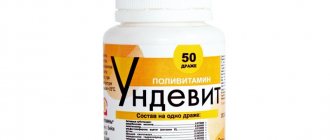Tampons are most often chosen by women who lead an active lifestyle. After all, with sanitary pads it is difficult to play sports, swim, and it is dangerous to wear light and tight clothes. How to use these products correctly, how to determine the required size and absorbency? Are tampons harmful? After reading the article, you will learn about the features of their use.
What is a modern tampon?
A modern product does not cause any harm to a woman if she is completely healthy. If there is a need for use, then you can use this remedy, but you should carefully study the pros and cons.
Is it harmful to wear tampons? Currently they are:
- Small elongated objects made from environmentally friendly materials. The main component of the product is cellulose, which does not cause any harm.
- The hygiene product contains an applicator that allows you to quickly remove the tampon to replace it.
- The product absorbs liquid and adapts to the anatomical features of the woman’s body.
- Modern materials do not allow it to accumulate secretions on top of the product.
Tampons have many differences from products that were produced in the last century. However, they have a number of features that must be taken into account when using.
Common Myths
Are tampons harmful? Here are the most common prejudices regarding their use:
- Tampons are harmful to the body. Some women believe that menstrual blood should flow outward rather than pool inside the body. However, the product copes with its task perfectly and absorbs liquid while in the vagina. Bacteria do not have time to multiply, because the maximum period for using a tampon is 4 hours. Then it is replaced with a fresh one. The occurrence of toxic shock syndrome is possible only in 0.004% of women.
- The product is prohibited for use by virgins. However, the hymen is quite stretchable, and during menstruation it becomes even more flexible. The tampon is placed at a shallower depth and does not touch it.
- The product may fall out of the vagina. When defecating, the product remains in place. The tampon may fall out if the discharge contains a lot of mucus. In such cases, additionally use a sanitary pad.
- The tampon may become stuck in the body. All products have a return cord, allowing it to be removed outside. Girls who constantly use these products know that there are some obstacles when pulling them out. This is explained by the fact that when filled, the tampon increases in size. Even if the cord breaks, which is unlikely, once the tampon is saturated, it will come out of the vagina on its own.
- The product is difficult to change outside the home. This will only take 2 minutes. Hands must be washed with soap before the procedure. After removal, they need to be wiped with a damp cloth. The easiest way to do this is in the toilet.

Are tampons harmful during menstruation? If the rules for using products are strictly followed, they do not adversely affect a woman’s health.
Design and packaging [ edit | edit code ]
There are a variety of shapes and colors of tampons, which are responsible for the degree of absorption and packaging. The appearance of tampons from different brands differs little, but the level of absorption and workmanship are different for everyone.
The main difference between all tampons is the method of insertion into the vagina. Thus, tampons can be applicator (inserted through a special tube) and non-applicator (inserted using a finger). Different types of tampons expand differently during use. For example, tampons with an applicator, such as Tampax and Natracare, expand axially (increase in length). Tampons such as ob, Natracare and Lil-lets without applicators expand radially (increase in diameter). Most tampons have a drawstring to remove the tampon from the vagina, some tampons have an additional outer shell to make insertion and removal easier.
Most tampons sold today are made from rayon or rayon cotton. Organic cotton tampons are made from 100% cotton. Each tampon is individually packaged.
The applicators are made of plastic or cardboard and are similar in design to a syringe. The applicator consists of two tubes: an external (cylinder) and an internal (pushing) element. The outer tube has a smooth surface to facilitate insertion of the tampon and sometimes has a rounded end with petals.
Types and sizes of tampons
Products are distinguished by the amount of liquid absorbed. Are tampons harmful for women? To ensure that they do not have any negative effects on the body, they must be chosen correctly.
Before being released for sale, tampons are tested using an artificial vagina. Products are tested for absorbency using synthetic blood. This indicator is indicated in the form of droplets. Absorption level classification:
- 1 drop - minimal absorption during light menstruation.
- 2-3 drops. Average absorbency for normal periods.
- 4-5 drops. For heavy discharge.
When choosing tampons, you need to consider absorbency and size. Mini products are suitable for young and nulliparous girls. It is best for adult women to use standard tampons, while mature women and women in labor use maxi tampons.
Products can be with or without an applicator. A tampon without an applicator has a rigid cylindrical shape with a rounded end. Products with a plastic device are softer, so without them it will not be possible to introduce the product into the body.
For the first time, it is best for women to use a tampon with an applicator, because without it nothing may work. They are easy to administer; you need to wash your hands before starting the procedure.
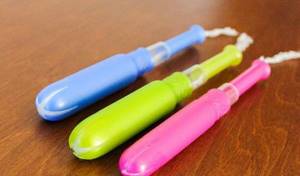
Women should be aware that products with applicators increase in length when filled, so the edge of the tampon may put pressure on the entrance to the vagina. It is best to inject the product deeper. Rigid products that are inserted with a finger expand in width while remaining unchanged in length.
Which tampons are better and how to choose them correctly
An excellent solution for maintaining an active life will be sanitary tampons. A suitable product will not irritate the skin, will provide reliable protection against leaks and will make critical days as comfortable as possible.
When choosing suitable tampons, you first need to pay attention to the degree of absorption. It should be chosen individually, depending on the amount of menstrual flow in a woman.
If the degree of absorption is too low, the product may leak during heavy menstruation.
In another case, when the degree of absorption is greater than necessary, the tampon will dry out the vaginal mucosa, which may result in microflora disturbance and inflammation.
When purchasing these hygiene products, pay attention to a few things:
- Tampon size;
- Surface coating;
- Availability of applicator;
- Degree of absorption.
Tampon size
Here you can divide the hygiene product into several categories, namely:
- Mini - designed for scanty discharge, can be used at the very end of menstruation;
- Normal - this size is suitable for women with a small amount of discharge; such tampons are also ideal for the end of menopause;
- Super - suitable for long-term heavy discharge, good in the first days of the menstrual cycle;
- Super plus - suitable in cases where there is a lot of discharge, ideal for sleep, since it best protects against leakage.
Many women have the heaviest discharge at the beginning of the cycle, and it decreases with each subsequent day. In this case, it is recommended to purchase packages of tampons of different types in order to switch from “super” to “normal” or “mini” at the right time.
With or without applicator
Among modern hygiene products, tampons with applicators are increasingly common. They provide the greatest comfort when administering the product.
The applicator is made of cardboard or plastic, which makes it smooth, and therefore the product is easily administered, minimizing discomfort during the process.
In addition, the presence of an applicator will protect against the entry of various bacteria into the body, and therefore it is not only convenient, but also the safest means.
Every woman faces critical days. Sometimes they only take a few days, other times they last a week or even more. To lead a normal, fulfilling life during menstruation, you need to choose the right hygiene product. Pads are not suitable for everyone - you have to avoid going to the pool, wearing tight-fitting clothes, and much more.
Possible problems when using tampons
Despite its convenience and practicality, there are times when you should refrain from using such a hygiene product. If the tampon is incorrectly selected or there are contraindications (allergy to the material, individual intolerance, disease), the following problems may occur:
- Toxic shock syndrome. Occurs when there is an individual intolerance or the product is left inside for too long (manufacturers indicate on each package that the tampon should not be kept in the body for more than 8 hours). If after use you feel like you have the onset of flu or fever, you should immediately remove the product.
- Development of pathogenic microflora. Occurs if an error was made during the administration of the drug and the body was damaged. Harmful bacteria enter the bloodstream, which can lead to various diseases in the future.
- Irritation of the mucous membrane can occur if the size of the tampon is incorrectly selected, or if there are allergic reactions to its components. Also, such a remedy can cause the onset of an inflammatory process.
To avoid unpleasant consequences, it is important to carefully study the instructions written on the leak protection products. By making sure that the components of the tampon do not cause an allergic reaction, and also understanding exactly how they need to be inserted and how long to keep them inside, you will completely protect yourself.
Popular manufacturing companies
There are several well-known manufacturing companies. To understand which tampons are best to use, you need to familiarize yourself with the features of each of them:
- Tampax was the first to establish itself as a manufacturer of reliable products. Tampons are made from specially treated cotton fiber combined with viscose. There are models on sale with and without applicators;
- Kotex makes tampons from viscose fibers, which makes the product more flexible and can be positioned optimally inside the vagina. Kotex also comes with an applicator.
- ob produces tampons that maintain the required level of vaginal flora. The products are equipped with spiral grooves, which additionally protect against leaks, and the coating of the tampons is silky to the touch, which facilitates the process of inserting and removing the product.
Number of reads: 1069 01/29/2019
Source: https://ginekologi-msk.ru/info/articles/kakie-tampony-luchshe/
Rules of application
Is it harmful to use tampons during menstruation? Usually, negative effects on the body occur if women use the products incorrectly. To prevent this, you need to read the instructions for using tampons.
It includes the following items:
- It is best to use the products in the first days of menstruation. At this time, there is especially heavy discharge, so completely reliable protection is needed.
- You need to use tampons with varying degrees of absorbency. On days when the discharge is especially heavy, you need to use “Super” or “Super Plus”, and on other days “Normal”.
- Products must be changed every 4 hours. It is not recommended to use tampons at night due to their limited time of use. It's better to use regular gaskets.
- Tampons must be inserted correctly and with clean hands.
Are tampons harmful? Danger can only arise if used incorrectly. Women should not forget them in the vagina and need to select them taking into account the degree of absorption and size.
Tampons not intended for menstruation
There are tampons that, despite their similarity to hygienic ones, are not hygienic. They are used for medicinal purposes or as an additional means of contraception.
Chinese tampons for treatment
Manufacturers claim that Chinese tampons with medicinal herbs will be very useful in the following cases:
- Endometriosis;
- Inflammatory diseases of the uterine appendages;
- Candidiasis and vaginitis;
- Menstrual irregularities;
- Venereal infections;
- Infertility.
Such vaginal tampons are also used as a protective barrier when visiting a swimming pool or sauna, as well as after sexual intercourse with dubious partners. A ban on their use exists when:
- Allergies to the components of this product;
- Menstruation.
It is worth saying that such tampons are not actually medicine. And you should not use them for the listed diseases and other circumstances at your own peril and risk. What is alarming, in particular, is the recommendation to keep the inserted tampon in the vagina for 3 days, large lists of medicinal plants and ailments that are promised to get rid of, as well as the absence of contraindications. What is certain is that tampons alone cannot cure such serious gynecological problems as those listed in the annotations to them. And if a woman wants to experience their effects, it makes sense to notify the attending physician and ask his opinion.
Homemade medicinal tampons
To speed up recovery, it is better to use gynecological tampons made with your own hands. For this you need:
- Bandage size 15-20 cm;
- Gloves;
- Cotton ball;
- Scissors;
- Threads;
- Disinfectant solution.
All components must be sterile, scissors are also disinfected. A thread is secured inside the cotton wool so that it hangs down, and the whole thing is wrapped in a bandage. The finished tampon is moistened with medicine. Typically used:
- Healing mud for the treatment of colpitis, adnexitis, cervicitis. In this case, it is applied not to a bandage, but to cotton wool. Mud dilates blood vessels, increases blood flow, which promotes tissue regeneration;
- Aloe for getting rid of various types of inflammation of the vagina and other pelvic organs;
- Propolis for speedy postoperative rehabilitation, as well as treatment of cystitis, erosion, recovery from certain sexually transmitted infections.
Any type of tampon should be used only with the permission of a gynecologist.
Tampons-contraceptives
If it is impossible to protect yourself with other contraceptives, you should use a local one containing benzalkonium chloride. These contraceptive tampons are used:
The product is inserted into the vagina so that it comes into contact with the cervix. The effect of its presence lasts throughout the day and begins immediately. After some time, the tampon should be removed. This can be done 2 hours after vaginal sex. You cannot protect yourself with these types of tampons if:
- Colpitis;
- Inflammation of the vagina and uterus;
- Intolerance to the components of the product.
If after administering this remedy a woman feels a burning sensation and itching, it is necessary to remove it and take an antihistamine, because this is how allergies manifest themselves. There are a few more rules that will make vaginal tampons more effective:
- Regular use before each contact;
- Correct and sufficiently deep insertion (7 cm). It's better to do this lying down;
- Do not use soap for washing before and after intercourse for 2 hours;
- Do not take a bath or swim with a tampon inside;
- Do not use it to avoid pregnancy at the same time as other drugs administered vaginally.
Among the most used tampons for such purposes are:
When using different types of tampons, you must remember that the sterility requirements are the same as for pads. That is, it is necessary to wash your hands before replacing them and also carefully monitor the cleanliness of the genitals. To avoid the negative consequences of using tampons during menstrual periods, it is better to alternate them with pads.
This is how you should introduce the hygiene product. Many people get so used to the comfort that sanitary tampons provide that they don’t even want to use a pad.
In this regard, the question arises about hygiene products for critical days. . Tampon and anatomical features. Hygienic tampons are...
Pads or tampons. Monthly menstruation is an inevitable phenomenon, requiring a woman to be especially careful about hygiene.
Tampons are the most convenient hygiene item for women, as they are invisible under a transparent dress and open swimsuit.
They will not be able to provide sufficient hygiene and comfort on critical days. . Tampons made of gauze or bandage. Before you start making a tampon, you need to.
Hygiene during menstruation. Young women and girls have regular... These are special sanitary pads for critical days and tampons.
Why do you need to change tampons often?
It is not recommended to wear such hygiene products for a long time. This may lead to the following:

If you adhere to these rules and change the product on time, then questions about whether tampons are harmful will not arise.
How to use gynecological tampons?
Such products are most often used to treat: candidiasis, inflammatory processes in the uterus and ovaries, endometriosis, and cervical erosion.
Tampons in this case are made from sterile gauze. Various oils are used to treat female diseases; sea buckthorn oil is especially popular. It has antiseptic properties.
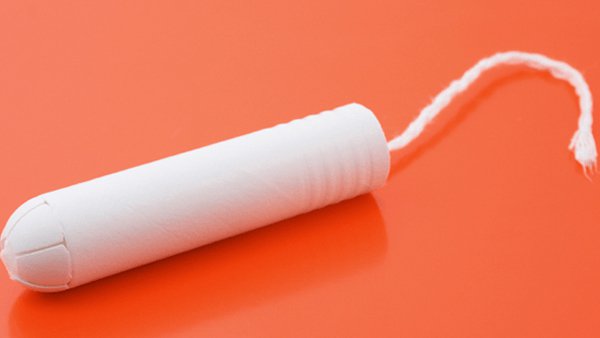
Tampons with sea buckthorn oil are used in the treatment of inflammatory processes. The process should be carried out under the supervision of a specialist and taking into account the individual characteristics of the woman’s body.
The main advantages of tampons
When used correctly, products can provide many benefits to a woman:
Is it harmful to use tampons constantly during menstruation? With all their advantages, there are also negative aspects to their use, so this should definitely be taken into account.
History [edit | edit code]
Women have used tampons during their menstrual cycle for thousands of years. In her book Everything You Should Know About Tampons (1981), Nancy Friedman writes [2]: “There is evidence that tampons have been used throughout history in a wide variety of cultures. The oldest printed medical document, the Ebers Papyrus, shows that soft papyrus tampons were used by women in Egypt in the 15th century BC. Roman women used wool tampons. Women in ancient Japan adapted to using paper tampons, which were held in place with a bandage and changed 10-12 times a day. Native Hawaiians used the fuzzy part of the native hapu'u tree fern; and many herbs, moss and other plants are still used by women in certain areas of Asia and Africa.”
According to the testimony of the Russian scientist-ethnographer of German origin Jacob Lindenau, a participant in the Second Kamchatka Expedition in 1739-1743, Koryak women “take a pinch of moss and stick it between their legs just like the Ostyak and Tungus women do, for whom these moss tampons are called Urup
and
Njoemack
;
the Koryaks call them Mullumoen
; they change them and burn them every morning, and during menstruation - two or three more times during the day.” [3]
The swab has been used as a medical device since the 18th century, when antiseptic cotton swabs impregnated with salicylates were used to stop bleeding from bullet wounds [4].
Doctors Earl Haas and Michael Dahn patented the first modern tampon, Tampax, with two applicator tubes. Gertrud Tendrich bought the patent rights to the Tampax brand from Haas and became a saleswoman and product spokesperson in 1933.[5] Tendrich hired women to produce the tampons and then hired two salespeople to promote the product in pharmacies in Colorado and Wyoming. She also hired nurses to lecture on the benefits of the product. She also played an important role by introducing public advertising in newspapers.
While studying female anatomy, German gynecologist Dr. Judith Esser Mittag, together with her husband Kyle Lucerini, developed the world's first finger-tampon without an applicator (ob). In the late 1940s, Dr. Karl Hahn worked with Hein Mittag to mass produce this tampon. Dr. Hahn sold his company to Johnson & Johnson in 1974 [6]. As of 2011, ob tampons are the sales leaders in their segment, with a market share of 37%, Tampax - 32%, Kotex - 27%, Ola - 10% and Libresse - 9% [ 7].
Negative sides
Are tampons harmful during menstruation? The products have a high degree of absorption, which causes the vaginal mucosa to dry out. This can cause microcracks and irritation, which will cause an inflammatory process.
The situation is usually complicated by the fact that the discharge cannot come out, thereby creating favorable conditions for the proliferation of pathogenic microflora. In combination with microcracks, this contributes to the development of inflammation, and in some cases even erosion of the cervix.
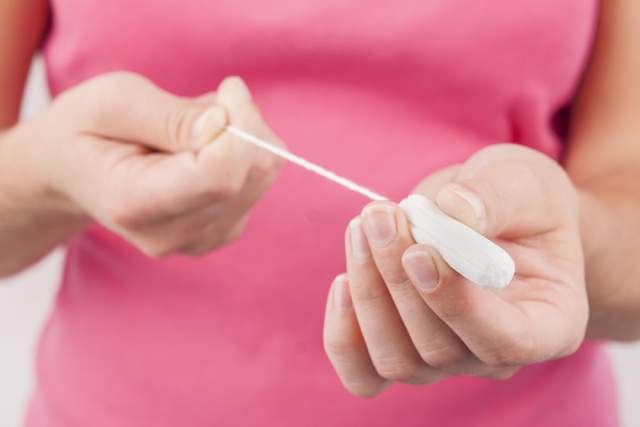
Active reproduction of pathogenic microorganisms causes one of the serious complications - toxic shock syndrome. Pathogens include bacteria pyogenic streptococcus, Staphylococcus aureus and clostridia.
Such pathogens are present in small quantities in any organism, but the use of tampons increases their growth significantly. This causes severe intoxication and deterioration of the general condition of the body.
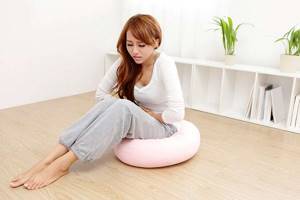
Is it harmful to use tampons all the time? This can cause toxic shock syndrome, the main symptoms of which are:
Sometimes the deterioration of a woman’s health is caused by the material from which the pads are made.
Is it harmful to use tampons? Dioxin, which is used to bleach cotton and viscose tampons, poses a particular danger to the body. The substance is a carcinogen and has a toxic effect on women's health. Regular use of tampons can lead to infertility.
Contraindications
Are tampons harmful for women during menstruation? It is strictly forbidden to use the product in the treatment of gynecological diseases with special ointments and suppositories. When a tampon is inserted, it absorbs the medication and interferes with the therapy process.
The products are not suitable as a replacement for daily sanitary pads. Gynecologists prohibit their use in the following situations:
- For inflammation of the genital organs and uterus.
- Allergic reaction to product components.
- In the first months after the birth of the child.
- For severe pain in girls who are not sexually active.
- Chronic dryness of the vaginal mucosa.
In other cases, a woman can use tampons if this type of protection suits her.
Tampons and virginity [edit | edit code ]
According to doctors, virginity is not an obstacle to using tampons [9]. The hymen is a mucous membrane with a hole in the center through which, in particular, menstrual blood flows. This opening is large enough for a pediatric gynecologist to perform digital vaginal examination and vaginoscopy (using instruments) [10]. In addition, in girls over 13 years of age, the hymen is very stretchable; during menstruation it becomes even more elastic [10]. In 2001, in an interview with the newspaper “Arguments and Facts Health,” Doctor of Medical Sciences, chief pediatric gynecologist of Russia Elena Uvarova explained:
Today, menstruation occurs on average at the age of 12.5-13 years. At this time, the diameter of the so-called hymenal opening in the vagina reaches 1.5 - 2.0 cm. For comparison, the maximum diameter of applicator tampons is 1.3 cm. When saturated with menstrual fluid, the tampon increases primarily in length rather than in width. During menstruation, the hymenal opening enlarges, and the hymen becomes more elastic. These anatomical features allow the use of tampons from the first days of menstruation.
Only some anomalies in the structure of the hymen serve as an obstacle, but they occur, as studies show, in no more than 1% of cases [11].
Thus, with proper use of tampons, it is impossible to damage the hymen [9] [12].
Some gynecologists recommend that adolescents use tampons on the second day of menstruation, when the stretchability of the hymen is maximum [13].
If the hymen is too thick or has a very small hole (it is impossible to insert even a finger, inserting tampons causes pain), you should consult a gynecologist [9].
Doctors' opinions
Is it harmful to use tampons during menstruation? These days, no one will be surprised by such hygiene products. They are really convenient for traveling and traveling.
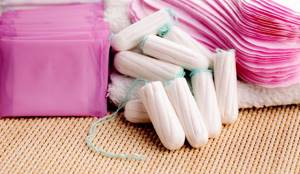
Gynecologists do not always have a negative attitude towards them. When used correctly, they cannot harm the body. The main thing is to consider the following:
Women should choose tampons that are ideal for the degree of discharge.
What types of tampons are there?
The tampon is made of a special fiber that has pronounced absorbent properties. More often, tightly compressed viscose fibers are used, less often - cotton wool. Their main task is to retain the entire volume of secretions inside. The filler is stitched.
Therapeutic tampons are impregnated with special substances - anti-inflammatory, antiseptic, as well as herbal decoctions. Their task is to help in the treatment of inflammatory infectious diseases and relieve pain.
When using tampons, we must not forget that there are several types of tampons:
- Mini - small in volume, suitable for light discharge or on the first and last days of menstruation.
- Normal - used for moderate menstruation.
- Super - suitable for use in the middle of the cycle, when the discharge is abundant.
- Super plus - for long-term wearing, for example during trips or at night, as well as with heavy movements.
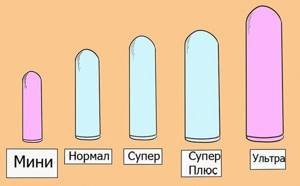
Accordingly, the wrong choice of size leads to the fact that inserting a tampon is painful, and when it swells from discharge, the discomfort intensifies. Normally, no unpleasant sensations are observed, the tampon is not felt, and with proper changes (at least once every 3-4 hours) there is no blood leakage.



